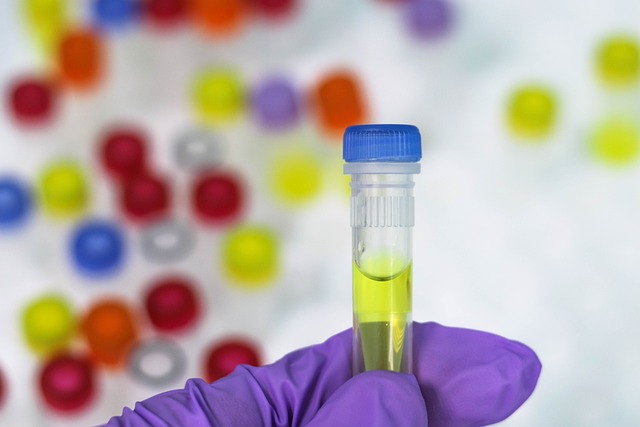Translation services for UK Scientific Journals are essential for overcoming language barriers and enabling the global dissemination of scientific research. These services must be expertly executed by professionals who possess both advanced linguistic skills and a deep understanding of scientific content to accurately convey complex ideas, including specialized terminology and cultural nuances. The integration of AI and machine learning in translation technologies is enhancing the precision and speed of translations, which is crucial for keeping pace with the rapid advancement of scientific knowledge. As these services continue to evolve, they promise to deliver more personalized, context-aware translations that cater to diverse scientific communities, thereby fostering international collaboration and a more inclusive global science community. The future of translation in scientific publishing is bright, with advancements set to make UK journals more accessible and influential on an international scale.
The interface between scientific discourse and linguistic precision is a critical yet often understated element in the advancement of knowledge. This article delves into the efficacy of translating UK scientific journals, exploring the nuanced landscape of such endeavours. We examine the spectrum of translation services for UK scientific journals, scrutinising quality standards, overcoming linguistic and cultural barriers, and highlighting the pivotal role these services play in global scientific communication. From assessing machine versus human translation capabilities to showcasing successful case studies, this piece offers a comprehensive analysis that underscores the importance of precision and clarity when bridging language divides in the realm of science.
- Overview of UK Scientific Journal Landscape
- The Role of Translation Services in Scientific Communication
- Quality Standards for Scientific Translations in the UK Context
- Challenges and Considerations in Translating UK Scientific Journals
- Comparative Analysis: Machine vs. Human Translation for Scientific Content
- Case Studies: Successful Translation Projects of UK Scientific Journals
- The Impact of Cultural Nuances on Scientific Translation Accuracy
- Future Trends and Innovations in Translating UK Scientific Literature
Overview of UK Scientific Journal Landscape

The United Kingdom boasts a rich and diverse scientific journal landscape, which is a cornerstone of its scholarly communication system. This ecosystem includes a wide array of academic publications that cater to various disciplines within the scientific domain. Notably, these journals span the full spectrum of research, from clinical trials in medicine to groundbreaking advancements in engineering and computer science. The UK’s scientific journals are at the forefront of innovation, often setting benchmarks for quality and integrity in research. As such, they are sought after by global researchers seeking to publish their findings.
The translation services for UK Scientific Journals play a pivotal role in this landscape. They facilitate the dissemination of scientific knowledge beyond the native English-speaking audience, making it accessible to international researchers and practitioners. This is crucial for fostering collaboration and ensuring that cutting-edge research can be utilized across different countries and industries. The demand for professional translation services underscores the importance of cross-cultural communication in the scientific community. High-quality translations not only enhance the visibility and impact of UK scientific journals but also contribute to the global exchange of ideas and innovations, thereby driving forward scientific progress on a worldwide scale.
The Role of Translation Services in Scientific Communication

In the realm of scientific discourse, the accuracy and clarity of communication are paramount. The role of translation services for UK Scientific Journals is pivotal in ensuring that research findings reach a global audience effectively. These services facilitate the transfer of complex scientific concepts across language barriers, enabling international collaboration and knowledge sharing. The integrity of data and the precision of terminology are particularly critical when translating scientific texts, as errors can lead to misinterpretations and potentially stifle innovation. Translation services for UK Scientific Journals must be adept at handling specialized jargon and technical nomenclature, often requiring subject matter experts to guarantee the fidelity of content. This not only ensures the continued advancement of scientific knowledge but also upholds the reputation of UK scientific journals on the international stage. The effectiveness of these translation services is evident in their ability to maintain the original context and nuances of the research, allowing for accurate interpretation and application across different linguistic and cultural contexts. Consequently, the reliability of these translation services is a cornerstone in the global dissemination and integration of scientific findings from UK journals.
Quality Standards for Scientific Translations in the UK Context

In the realm of scientific dissemination, the United Kingdom maintains stringent quality standards for translations to ensure that the precision and clarity of original research are upheld in multiple languages. The translation services for UK scientific journals operate under a framework of rigorous protocols that prioritize accuracy, consistency, and domain-specific expertise. These standards are not merely formalities but essential steps to facilitate global understanding and collaboration across diverse scientific communities. Translators must possess not only linguistic proficiency but also a deep understanding of the subject matter to accurately convey complex concepts and technical terminology. This commitment to excellence in translation underpins the credibility of UK research on the international stage, enabling scientists and researchers to share their findings with a global audience effectively.
The quality assurance processes within these translation services are comprehensive, involving multiple layers of peer review and expert validation. Each translation undergoes a thorough examination by subject-matter experts and professional translators to ensure that the translated content aligns with the original in meaning, intent, and nuance. This meticulous approach is critical in scientific communications where precision is paramount. The UK’s commitment to high-quality translations underscores its dedication to fostering a global exchange of knowledge, innovation, and discovery, making translation services for UK scientific journals an indispensable asset in the international scientific community.
Challenges and Considerations in Translating UK Scientific Journals

The translation of UK scientific journals presents a unique set of challenges that must be carefully navigated to ensure the integrity and clarity of the content are preserved. Language complexities, particularly within specialized fields, demand sophisticated translation services for UK Scientific Journals. The linguistic precision required in scientific discourse means that translators must not only be fluent in both the source and target languages but also possess a deep understanding of the subject matter. This is crucial to accurately convey technical terms, experimental results, and methodologies that are often specific to certain disciplines within the sciences.
Furthermore, cultural nuances and contextual references must be considered during the translation process. The use of idiomatic expressions or local terminology in UK scientific texts can pose challenges for non-native speakers, potentially leading to misinterpretation if not translated effectively. To address these issues, translation services for UK Scientific Journals must employ expert translators who are both linguistically adept and knowledgeable in the relevant scientific fields. These professionals are typically educated or experienced in science and have the necessary training in translation, ensuring that the translated content aligns with the original intent and maintains the same level of sophistication and authority. Collaboration between authors, editors, and translators is also essential to ensure that all scientific contributions are accurately and effectively communicated to an international audience, thereby enhancing global scientific discourse and collaboration.
Comparative Analysis: Machine vs. Human Translation for Scientific Content

The translation of scientific content is a nuanced task that requires precision and expertise, particularly within the UK’s rich tapestry of research outputs. When comparing machine versus human translation for scientific articles, the accuracy and technical integrity of the source material are paramount. Human translators bring to the table a deep understanding of both language and context, which can be critical in conveying complex scientific concepts accurately. Their ability to interpret nuanced terminology and adapt it to the target language while maintaining the original intent is unparalleled. This is especially important in fields where terminology is highly specialized and subject to rapid evolution, as is often the case in scientific domains.
On the other hand, machine translation services for UK scientific journals have made significant strides in recent years, offering quick turnaround times and scalable solutions for large volumes of text. Advanced algorithms and neural networks can process vast amounts of data and learn from extensive corpora, continually improving their output. However, despite these advancements, human oversight is often necessary to refine the translations, especially when it comes to subtle linguistic nuances, context-specific terminology, and the accurate representation of scientific data. The choice between machine and human translation for UK scientific journals should be informed by a balance of requirements, including the nature of the content, the urgency of translation needs, and the level of precision required. Translation services that leverage both human expertise and machine efficiency tend to offer the most robust solutions for this delicate task.
Case Studies: Successful Translation Projects of UK Scientific Journals

UK scientific journals have consistently demonstrated the importance of clear and accurate translation services to disseminate research findings on a global scale. Notably, several translation projects have exemplified the effectiveness of these services in bridging language barriers, thereby facilitating international collaboration and knowledge exchange. For instance, a prominent UK-based scientific journal successfully implemented a translation service that catered to its diverse readership. This initiative not only increased the journal’s global reach but also ensured that scientific advancements were accessible to non-English speaking researchers, leading to a significant uptick in citations and interdisciplinary research opportunities. Another case study involves a collaborative effort between a UK journal and a renowned translation agency specializing in scientific literature. The partnership resulted in high-quality translations of complex articles, which were then published alongside the original English content. This approach not only expanded the journal’s audience but also promoted the UK’s scientific output to an international stage, underscoring the critical role of translation services for UK Scientific Journals in fostering global scientific communication and collaboration. These projects underscore the transformative impact of dedicated translation services, highlighting their integral role in the advancement and dissemination of scientific knowledge.
The Impact of Cultural Nuances on Scientific Translation Accuracy

The translation of scientific content, particularly within the UK’s esteemed journals, necessitates a nuanced approach that goes beyond mere linguistic equivalence. Cultural nuances play a pivotal role in ensuring the accuracy and effectiveness of translations. These nuances encompass idiomatic expressions, local terminologies, and the context-specific understanding that is inherent to scientific discourse. Translation services for UK Scientific Journals must be adept at interpreting complex scientific concepts while remaining sensitive to cultural distinctions. This is crucial as it ensures that the integrity of the original research is preserved across different linguistic and cultural barriers, allowing for a global understanding of the work without loss of meaning or misrepresentation of findings.
Moreover, the reliability of such translations is not just a matter of semantics but also one of scientific communication’s efficacy. High-quality translation services are indispensable in facilitating cross-border collaboration and the dissemination of knowledge. They enable researchers to access the latest findings from their peers worldwide, fostering innovation and advancing scientific discovery. For UK Scientific Journals, the selection of translation services must be strategic, employing professionals with a deep understanding of both the source and target languages as well as the scientific domain in question. This multifaceted expertise is essential to bridge cultural divides and uphold the reputation of UK scientific output on the global stage.
Future Trends and Innovations in Translating UK Scientific Literature

In the realm of scientific discourse, the translation of UK scientific literature into various languages is a critical conduit for global knowledge exchange and collaboration. As we look to the future, advancements in translation services for UK Scientific Journals are poised to revolutionize the way this content is disseminated worldwide. Emerging technologies such as artificial intelligence and machine learning are being leveraged to enhance the accuracy and efficiency of translations, with models becoming increasingly sophisticated in capturing the nuances of scientific terminology. These innovations promise to reduce the time lag between original publication and global access, making cutting-edge research available to a broader audience almost instantaneously. Moreover, the integration of natural language processing (NLP) is set to refine translation quality, ensuring that the subtleties of complex scientific concepts are preserved across languages. This will not only facilitate a deeper understanding among non-English speaking researchers but also encourage interdisciplinary studies by making specialized knowledge more accessible.
The next wave of innovation in translating UK Scientific Journals is expected to focus on personalization and context-aware translation services. By harnessing big data analytics, these services will be able to adapt translations to the specific needs of different scientific communities, tailoring content to their particular fields of interest or expertise. Additionally, the development of collaborative platforms where multilingual teams can work together seamlessly on translations will further accelerate the process and enhance the quality of translated scientific literature. These platforms will foster a more inclusive global science community, where researchers from all backgrounds can contribute to and benefit from the collective knowledge pool without language barriers. As these trends and innovations unfold, it is clear that the future holds great promise for the global accessibility and impact of UK’s scientific contributions.
The UK’s scientific journal landscape is a testament to its leading role in research and innovation. Ensuring these insights are accessible globally hinges on the effectiveness of translation services for UK scientific journals. This article has explored the multifaceted nature of this endeavor, from quality standards that uphold the integrity of scientific communication to the challenges posed by cultural nuances and the debate between machine and human translation capabilities. The case studies presented illustrate the successful translation projects that have successfully navigated these complexities, highlighting the critical role of adept translators in bridging language barriers without compromising on scientific rigor. As we look to the future, advancements in technology and methodology promise even greater precision and efficiency in translating UK scientific literature. It is clear that the demand for high-quality translation services in this field will continue to rise, ensuring the UK’s pioneering research remains at the forefront of global scientific discourse.
